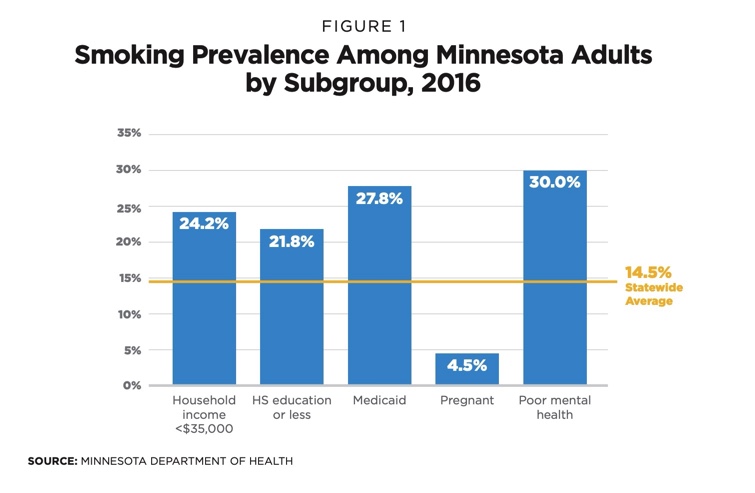How lawmakers should approach tobacco control policy
To effectively address public health concerns related to smoking, state, and local lawmakers should promote access to safer tobacco alternatives. Lawmakers ought to:
- Tax e-cigarettes more favorably compared to traditional cigarettes
- Limit restrictions on e-cigarettes
Despite progress, smoking is still a major public health concern
In 1999, about 23 percent of Minnesota adults reported smoking cigarettes regularly. But by 2018, that number was down to just 13.8 percent. Similarly, in 2000, nearly one in every three Minnesota high school students –– 32.3 percent –– reported smoking a cigarette regularly and by 2020 the rate was just 3.2 percent.
Figure: Smoking rates by age group

Despite this trend, costs from smoking are still significant. The Minnesota Department of Health estimates that Minnesota loses 6,300 people every year from smoking-related deaths and spends about $3 billion in excess health care each year due to smoking-related diseases and hospitalization (not to mention the billions lost in productivity due to smoking).
Harm reduction can help
Minnesota could benefit from less smoking. But progress in smoking reduction, especially among adults, has stalled. Fewer people have reported making attempts to quit smoking in recent years compared to past years. And among those that make attempts, even fewer have successfully quit.
Given that cigarettes are addictive, and that long-term and regular smoking is much more common among disadvantaged groups –– such as people with mental health issues or low socioeconomic status who are less likely to be deterred by high prices –– conventional tobacco control methods like tax hikes and restrictions likely will not help.

Fortunately, other nicotine delivery systems that are much safer than cigarettes exist. So, to effectively address the health concerns related to smoking, policymakers need to consider promoting access to these products to reduce the harm that smokers who can’t or won’t quit present to themselves and others.
Tobacco harm reduction
Nicotine is an addictive drug, but it is not a particularly harmful drug. According to the FDA, “it is the mix of chemicals” from tobacco and tobacco smoke that “causes serious disease and death in tobacco users, including fatal lung diseases, like chronic obstructive pulmonary disease (COPD) and cancer” and not nicotine itself.
Other tobacco products like electronic cigarettes, since they do not employ combustion, produce little to no toxins compared to smoking. Studies have estimated e-cigarettes to be as much as up to 95 percent less harmful than traditional cigarettes. Not only that, but e-cigarettes have also been found to help smokers quit or help accelerate quit rates, especially when combined with other methods like behavioral support.
Encouraging smokers –– especially those that can’t or won’t quit smoking –– to switch from cigarettes to these less harmful products by promoting access is a strategy that can reduce the harm associated with smoking.
What policymakers should do
To promote access to safe tobacco alternatives, policymakers should:
1. Tax e-cigarettes more favorably compared to traditional cigarettes
Economically speaking, electronic tobacco products and traditional cigarettes are substitutes. Consequently, any policy that increases (decreases) the cost of obtaining e-cigarettes compared to combustible cigarettes would discourage (encourage) smokers from switching to e-cigarettes.
Tax hikes on e-cigarettes increase the cost of obtaining e-cigarettes compared to traditional cigarettes and thus discourage switching. A 2020 study found that when Minnesota imposed a 95 percent wholesale tax on vapor products when they were first introduced, more than 32,000 smokers were deterred from quitting cigarettes and transitioning into e-cigarettes.
Policymakers should consider taxing e-cigarettes significantly more favorably compared to traditional cigarettes to make it cheaper for users to switch to these less harmful alternatives.
2. Limit restrictions on e-cigarettes
Much like taxes, restrictions on e-cigarettes like full bans or age restrictions also discourage smokers from switching to safe alternatives and should not be pursued. Research evidence suggests that laws that restrict access to cigarettes –– especially flavored ones –– reduce the appeal for smokers to switch and encourage smoking among the youth. Policies to ban flavored e-cigarettes in San Francisco, for instance, doubled smoking rates among youths.
Indeed, e-cigarettes are not 100 percent risk-free, but they are significantly safer than traditional cigarettes. Evidence indicates that individuals that only use e-cigarettes long-term have been found to have considerably lower levels of toxins and carcinogens compared to those using combustible cigarettes only. Not to mention that e-cigarettes are also effective at helping people quit smoking, in some studies at higher rates compared to nicotine replacement therapy.
Lawmakers should stop demonizing vapor products and instead adopt a pragmatic regulatory approach. This includes refraining from fully banning or restricting access to e-cigarettes, especially for smoking adults who can greatly benefit from switching. Local policymakers should especially refrain from enacting local restrictions on less harmful tobacco products.
Conclusion
Tobacco control progress has slowed in Minnesota, especially among adults. Given the addictive nature of cigarettes and the fact that smoking is concentrated among disadvantaged individuals, tax hikes and prohibition are unlikely to work.
Policymakers should consider removing restrictions that discourage smokers from switching to safer tobacco products to effectively reduce the harm associated with smoking.